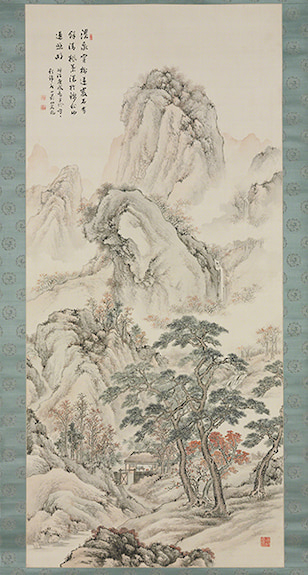It's Still Autumn: Noguchi Shōhin
It may feel like winter, but technically it’s still autumn until the 21st of December. I like nothing better than celebrating autumn—my favorite season in New England—with an artist I just learned more about: Shōhin Noguchi. She was active during the late Edo period (1615–1868) and the Meiji period (1868–1912) in Japan. It was a time when, like in the West, women artists were starting to find more acceptance and opportunities.
 |
| Noguchi Shōhin (1847–1917, Japan), Mountains in Autumn, 1910. Ink and colors on silk mounted as a hanging scroll, 74 ½" x 34" (189.2 x 86.4 cm). © 2023 Philadelphia Museum of Art. (PMA-9200) |
Scholars consider the painting style that evolved during the Southern Song Dynasty (1127–1279/1280) in China to be the classic example of Chinese monochromatic painting, particularly the "literati" (scholar/amateur) style. Noguchi emulated the literati artist style, enlarging forms and exaggerating brushwork. Unlike many Meiji Nan-ga (“southern painting style”) painters, there are few, if any, hints at the influence of Western art in this landscape. Noguchi’s use of mist to define depth through atmospheric perspective was executed in the traditional manner of transparent washes of diluted ink. Adhering to the Southern Song formula for a successful composition, the forms in Noguchi's landscape create a zigzag “path” for the eye to follow, so the viewer can enjoy the experience of mentally walking through the landscape.
A characteristic feature of literati painting was the inclusion of a poem, either by the artist or quoted from a revered ancient poet. The poem in this painting reads (per the Philadelphia Museum of Art):
A waterfall flows in amongst the trees and gushes forth again,
The cliffs and rocks have a lingering purity.
With maple leaves as vivid as brocade,
The autumn mountains return to their bright luster.
The forced opening of Japan to Western trade in the 1850s and the collapse of the Tokugawa dictatorship in 1868 led to the Meiji “Restoration” (1868–1912), in which military leaders attempted to put power back with the emperor. The Meiji leaders wanted to “Westernize” Japan and turn the country into an industrialized society to make Japan a major power.
After the opening of Japan to the West, the yō-ga (literally “Western style”) school of painting developed in the late 1870s. Not only were Western styles adapted, but also Western media such as oils and watercolors. Almost simultaneously, there arose a group of painters who strove to maintain the traditions of the Kanō school, literati landscape painting, and ukiyo-e. This group was known as the Nihon-ga, or “Japanese style painting” school. Many artists of the period executed works in both styles.
Born in Osaka, Noguchi studied painting from a young age. She was a keen follower of the Nihon-ga movement. Noguchi concentrated on the southern style of painting in her works, for which she received much fame and acclamation. Such was her fame that, in 1904, she was the first ever woman artist to become an “imperial household artist.”
Correlations to Davis Programs: Explorations in Art 2E Grade 2: 1.7; Explorations in Art 2E Grade 3: 5.6; Explorations in Art 2E Grade 6: 2.3, 2.4; Experience Art: 4.1; A Community Connection 2E: 4.5, 5.1; A Personal Journey 2E: 5.4; A Global Pursuit 2E: 7.5; Exploring Painting 3E: pp. 158–159; Discovering Art History 4E: 4.4


Comments